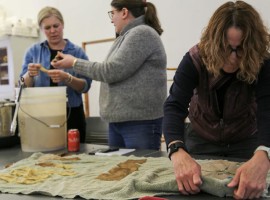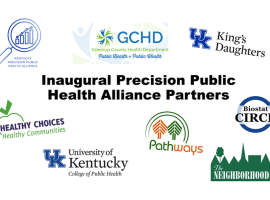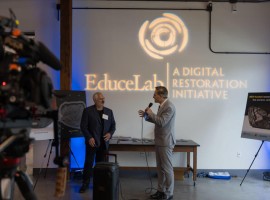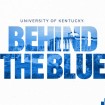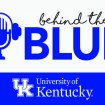'Behind the Blue': University of Kentucky Researcher Leads $3 Million Addiction Treatment Study
The University of Kentucky recently received $3 million from the National Institute on Drug Abuse and National Institute on General Medical Sciences to fund new opioid-related research in the criminal justice system.
Known as the Geographic variation in Addiction Treatment (GATE) study, the five-year project is led by Carrie Oser, professor of sociology in the UK College of Arts and Sciences. Oser and her colleagues will be focusing on the factors that influence a person’s decision to use one of the three FDA-approved medications for the treatment of opioid use disorder (OUD) — methadone, buprenorphine and extended-release naltrexone.
Although research shows that these medications are highly effective at reducing opioid use, infectious disease transmission and drug-related criminal behavior, uptake of these medications is low — only about 7% of people with OUD receive medications — and more than half of Kentucky counties do not have any providers who prescribe medications for OUD. It is even more challenging for those involved in the criminal justice system. In the past few years, the Kentucky Department of Corrections has addressed this issue by making naltrexone available inside their institutions and is currently piloting expansion at three prisons by offering buprenorphine to individuals with OUD who meet clinical and medical protocols.
On this episode of "Behind the Blue," Oser talks with UK Public Relations and Strategic Communication’s Allison Perry about the GATE study and its goals to identify how a person’s individual characteristics, personal networks and structural factors influence their decision whether or not to take medication for OUD both during incarceration and following release, and it will specifically look at the differences between urban and rural populations. While other studies have looked at individual and structural factors as predictors of medication use, this study is unique in its focus on the people surrounding the person with OUD and how their support — or lack thereof — and opinions influence decisions on taking medication.
"Behind the Blue" is available on iTunes, Google Play, Stitcher and Spotify. Become a subscriber to receive new episodes of “Behind the Blue” each week. UK’s latest medical breakthroughs, research, artists and writers will be featured, along with the most important news impacting the university.
For questions or comments about this or any other episode of "Behind the Blue," email BehindTheBlue@uky.edu or tweet your question with #BehindTheBlue.
To discover what’s wildly possible at the University of Kentucky, click here.
ALLISON PERRY: OK. Welcome to this edition of Behind the Blue. I'm Allison Perry with UK public relations and strategic communications, and today I'm here with Dr. Carrie Oser. So Carrie is a professor of sociology and the associate chair in the Department of Sociology in the University of Kentucky College of Arts and Sciences. She's also the associate director of the Center for Health Equity Transformation and a faculty associate in the Center on Drug and Alcohol Research. All right, thanks, Carrie, for coming in.
CARRIE OSER: Thank you for having me.
ALLISON PERRY: OK, so we're going to get started, and I kind of want to talk about some less serious fun stuff before we get into it like all the serious research that you're doing. And you are a Kentuckian, so tell me where you grew up.
CARRIE OSER: So I grew up in Louisville, and all my family is in Louisville, and when I was looking at universities, I thought about where I like to go to college. Of course, there's a university in my home city, and I chose not to go to that university. I also looked at options out of state, but I felt like UK was the best fit for me because of the high impact learning opportunities that were there and because of its national reputation and that it's a land-grant university, which is really what kind of education I wanted to receive.
ALLISON PERRY: I know, you already answered my next question, which was if you're from Louisville, why did you decide to come to UK? But tell me a little bit about your UK experience here.
CARRIE OSER: It was amazing. So I was a college athlete. I was on the UK dance team and got to perform at Rupp Arena and at the football games, and also I was involved in Greek life and some leadership opportunities at the undergraduate level. But what was really most important was the high impact learning experiences that I had in terms of research. I had amazing professors that invested in me as an undergraduate student, and I worked on some of their research projects. But I also had the opportunity to design my own research project and get internal grant funding to do that project.
And in that project, I went into prisons to look at individuals' self-esteem levels and see how that impacted engagement in various types of crime. And so that resulted in an undergraduate honors thesis that I then went on to present at a national conference, and I got my first publication with that research, and that set the trajectory for me to go on and have a career in academia and have an impact in terms of research.
ALLISON PERRY: When were you here at UK for your undergrad?
CARRIE OSER: I was here from-- it sounds like so long ago-- '94 to '98.
ALLISON PERRY: OK, so you would have been here during two--
CARRIE OSER: Two championships, yes.
ALLISON PERRY: What was that like?
CARRIE OSER: It was a crazy time, very amazing. And I just remember going to the intersection of Woodland and Euclid, and it was amazing. Yes.
ALLISON PERRY: Tell me how UK has changed since you've been here.
CARRIE OSER: Well, visually, it's changed in terms of the landscape. You know, I lived in Kirwan Tower, and now those towers are not going to be there anymore in just a short time. The new infrastructure and dorms are amazing. The Jacobs Science Building, and the College of Arts and Sciences has the technology that's available in that building for classroom instruction is really a transformative opportunity for students. The renovations in the law school, I mean, there's just been so much campus development over the years, and it's exciting to see how the landscape of the campus has changed.
ALLISON PERRY: It sounds like you got to participate research pretty early.
CARRIE OSER: I did.
ALLISON PERRY: At UK. I feel like we talk about that a lot now, but it always seemed to me like that was a relatively new development, but it sounds like it's not if you were already getting to be participating in research on that high of a level when you were here 20 years ago.
CARRIE OSER: I really think it's because of some exceptional faculty members that I had the opportunity to work with. And that's really what changes a student's investment in the university and their career trajectory. And I also want to say that when I came back to UK as a faculty member, I still had different senior scholars who were invested in my professional development as a junior faculty member. So that mentorship carries on throughout your career, and that just goes to show you how much UK faculty care about their students and also about other faculty.
ALLISON PERRY: When did you come back here as a faculty member?
CARRIE OSER: So I came back in 2004, and I was in the College of Medicine for two years before transitioning over to the College of Arts and Sciences in 2006.
ALLISON PERRY: I wanted to ask you what kind of drove you to pursue a career in sociology.
CARRIE OSER: I think it was a class that I took that was really eye opening, and the class had activities where you got out into the field to do research and some more qualitative investigations about how different neighborhoods, how they were designed and how that impacted the crime rates in those neighborhoods. And that was what really sparked my interest in sociology and in criminology specifically.
And then I got into the health focused research later on in my career. When I went to graduate school, I had the opportunity to be on a National Institutes of Health training grant, a T32 program, which trains pre-doctoral scholars or postdoctoral scholars, and was supported on that for five years during my graduate studies at the University of Georgia. And that was focused on the substance use treatment organizations, and so we looked at what sort of factors influenced whether or not substance use treatment organizations adopted and implemented novel treatment techniques.
And then when I was looking at career options, I always had in the back of my mind that I wanted to come back to UK because that's where home was. That's where my family was. I was invested in the university, and it worked out really well to have this opportunity to come back to my home institution and have an impact on the lives of Kentuckians, because when we're thinking about substance use problems. We have an opioid epidemic that's going on right now here in the Commonwealth and to be able to be part of that team to address that issue is really important to me, because I've had family members and friends who have substance use disorders. I've lost friends to overdoses, and it's just something that I feel really passionate about.
But I'm not the only one. I mean, there's a whole team of interdisciplinary scholars who are trying to address this substance use problems that are plaguing the Commonwealth, and so it's nice to have that team effort.
ALLISON PERRY: And that's a good transition for me to talk about. You are one of the researchers on the HEAL grant, which is UK's enormous $87 million grant we got earlier this year. So tell me kind of what you were bringing to the table for HEAL.
CARRIE OSER: Sure. The HEALing community study is a once in a lifetime opportunity. It's the largest grant, as you said, that UK has ever received, and I think it's one of the largest initiatives, if not the largest initiative, that the National Institutes of Health has ever invested in. It's over $350 million that they're investing in just to this one study. The HEALing community study is supporting four research sites, so in Kentucky, in Massachusetts, New York, and Ohio are the four states that are working on the HEALing community study.
And what we're trying to do is to work with community coalitions to develop a data-driven plan to deploy evidence-based practices. So we know what works in terms of reducing overdose deaths, but the challenge is that our communities maybe don't have the resources or don't have the infrastructure or don't have the knowledge to implement those evidence-based practices. And so what we're trying to do is to work with these community coalitions to use data about what's available in their community and where the needs are and to get interventions into the community to address overdose deaths.
Our goal is to reduce opioid overdose deaths by 40% within three years, which is an extremely challenging, ambitious goal, but I believe that we can do it, and we need to do it. We felt like it was a moral imperative for us to apply for this grant. It was an overwhelming process to create the application and took a lot of team effort and collaborations with our state partners and also our community-based organization partners that we feel like we'll have the real opportunity to make a difference.
But your question was about what my role is in that project. And so I will be working with the Kentucky Department of Corrections, which is one of our state partners through the Cabinet of Justice and Public Safety. And if community coalitions select criminal justice venues to deploy some of these evidence-based practices, then I'll be working with the coalitions and with the Department of Corrections to help deploy these interventions.
So when I say interventions, I mean things like overdose education and distributing naloxone or linkage to medications for opioid use disorder. That's what I mean by evidence-based practices. On the HEAL, I'm also working on the health communication campaign, so we want to make sure that in our communities that people know what evidence-based practices are available and where they're available. So we're doing a health communication campaign, and then I'm also working on the implementation science team.
So the implementation science is really focusing on how we translate these evidence-based practices into applied settings quicker, because that's the problem. Because on average, if we develop some new technology, medication, or therapeutic approach, it takes on average 17 years for it to get into the average clinical practice. And so implementation science is a study of how to expedite that process.
ALLISON PERRY: 17 years.
CARRIE OSER: 17 years.
ALLISON PERRY: Wow.
CARRIE OSER: Yes, it's what the literature shows.
ALLISON PERRY: And there are people who need it now.
CARRIE OSER: Yeah. Yeah, I mean, when we think about overdose deaths, a person dies approximately every 10 minutes. So if we wait 17 years, that's a lot of people.
ALLISON PERRY: Yeah. So one of the things that I've found really encouraging, everyone on HEAL is clearly very busy with HEAL we were just talking earlier that you've got a big deadline coming up, and everyone's really pushing to get things done. But you also have your own individual research projects you're working on. So let's talk a little bit about your new grant. You just got $3 million. Can you tell me who gave you the money and what it's for?
CARRIE OSER: Sure. So we're really excited about this project as well. This study is called the GATEs study, which stands for geographic addiction treatment experiences. And we are interested in looking at-- let me first tell you about who funded this study. This study is funded by the National Institutes of Health, specifically the National Institute on Drug Abuse and the National Institute on General Medical Sciences. They co-funded the project. And we're working with a wonderful team of investigators who are in the College of Medicine, Dr. Michelle Staton and Dr. Hannah Knudsen and then also a team of investigators at Indiana University, who have network science expertise, doctors Brea Perry and Kate Edens. And the project has also been supported by the Kentucky Department of Corrections, so we're really appreciative of their collaboration.
The GATEs study is focused on how networks influence people's decision making about whether or not they want to use medications for opioid use disorder. So currently, there are three FDA approved medications to treat opioid use disorder, methadone, buprenorphine, and extended release naltrexone. But the uptake of those medications is really slow. Sorry, not slow, but low, slow and low. Like less than 1% of people who have opioid use disorders receive medications.
And it's really a pronounced disparity in the criminal justice system. And so the Kentucky Department of Corrections has acknowledged this sort of deficit, and in the past two years, they have made available extended release naltrexone inside institutions, and they are getting ready to expand their medication for addiction treatment module to also include buprenorphine. And so it's an opportune time for us to study this and how people make the decision about whether or not they want to initiate medications.
And so we did a small pilot study first before we apply for this larger grant, and the pilot study highlighted the importance of social relationships, or what we call social networks, and there were indicators that people's social networks really matter. Most research studies individual factors and how they influence behavioral decision making or behavioral outcomes. So individual factors would be things like someone's motivation would be an individual factor. And then we also know structural factors matter, so if someone has insurance obviously influences whether or not they can access a medication for an opiate use disorder.
But what's kind of the black box are those relationships and how they influence decision making, so people that you talk to about your substance use disorder or how information might flow through that network to influence whether or not you pursue that avenue. That may not be the right avenue for everyone, but if they don't know about it or they don't have access to it, then that that can be a problem.
And so what our study is focused on is how people's social networks—and these are people who are incarcerated—influence the decision of whether or not to initiate the medication and how that affects reentry outcomes in both rural, as compared to urban areas. We're also interested in the dynamic nature of networks, because networks change, and especially when you go through a life experience, where you are re-entering society when you've been incarcerated for longer than a year period, your network may change. And so we want to see how networks change over time, and they could change for better or for worse in terms of the composition of your network or how it might be structured, and that can influence your reentry outcomes in terms of relapse or recidivism.
ALLISON PERRY: Can you talk a little bit about the potential stigma with taking medication for opioid use disorder and how that kind of plays into the network's influence?
CARRIE OSER: I think some of it's stigma, but some of it is also people just don't understand why medications might be needed, and opioid use disorders are different from other substance use disorders, because if someone say, for example, has an alcohol use disorder, and they relapse and use alcohol, they might have a bad hangover the next day, but that's kind of what the outcome would be, whereas if someone with an opioid use disorder relapses, and they've been incarcerated, and their tolerance has gone down, if they relapse, there's a high chance that they could experience an overdose and die, so it could be a fatal relapse. And that's what we want to prevent, and medications are one avenue to help prevent that fatal overdose experience.
ALLISON PERRY: So what would you say the ultimate goal of this study is?
CARRIE OSER: The ultimate goal is to study how networks influence people's decisions and how that influences their outcomes in both rural and urban areas and to help us identify points where we can intervene in the network. So maybe it's that there's a strong parental influence, and your parent is saying you've already gone through a substance use treatment program, you don't need to be on medication, you're already off of all substances. And if we had an educational intervention with family members in someone's network, then that could have an impact on improving their chances at having better reentry outcomes. So the ultimate goal is to intervene.
ALLISON PERRY: Do you want to say anything about working with the Department of Corrections on this? I know they've been involved in a lot of our projects, and it seems we're working pretty closely with them.
CARRIE OSER: The Kentucky Department of Corrections has been an amazing collaborator and partner. We've worked with them for about 15 or so years, and they've always been supportive of research, and they want to use data driven approaches. Their goal is public safety, but it's also to improve people's lives, and the Department of Corrections is actually the largest treatment provider in the state in terms of substance use treatment. And so they want to ensure that they're using best practices, and we are excited to have the opportunity to collaborate with them on the healing community study, on the state study that I just described, and then also on the JCOIN initiative that is the justice focused opioid network initiative as well.
ALLISON PERRY: Is there anything else that I haven't asked you about, any other projects or ongoing things you want to make sure that we know about?
CARRIE OSER: Not that I can think of.
ALLISON PERRY: Are you not are you not busy enough with HEAL and GATE and everything else going on?
CARRIE OSER: We're working hard. We're trying to make a big impact in a short amount of time.
ALLISON PERRY: Yeah. All right. Well, thank you, Carrie, for coming in.
CARRIE OSER: Well, thank you, Allison. I appreciate it.
ALLISON PERRY: And I'll let everyone know—for more information on the HEAL study, we actually have a website available, www.uky.edu/healingstudy, where you can find a more information about updates to HEAL. But again, thank you for coming in, and thanks everyone for listening.
